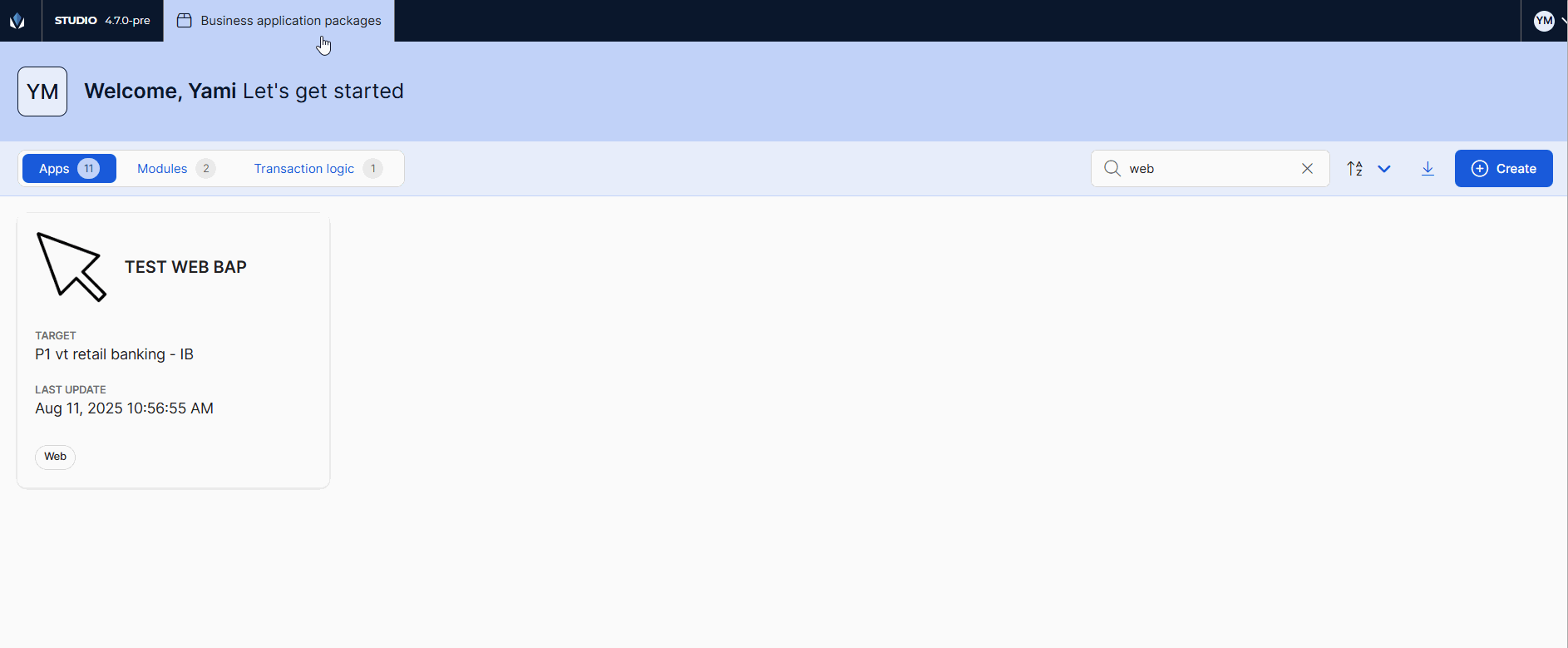Business Application Packages
A Business Application Package (commonly referred to as BAP) is a bundle that contains several of the necessary elements required to deliver a solution. It contains the app’s configuration, which consists of the app’s front-end with its modules and business logic, and configurable transactions, which consists of the app’s back-end, and includes external services, lambda libraries and action libraries in use within the transactions.
Important
There are other elements involved in a solution, but, since they are obtained from outside Studio, they are not within the BAP feature scope.
Creating a BAP helps automatically and securely generate deployment packages in Studio, while easily integrating configurations and configurable transactions. Using BAP provides the following benefits:
More agile app delivery.
Reduced human errors during the package assembly.
Improved traceability and transparency in changes.
Integrity between QA and production environments.
Validation of commits and dependencies before creating the package.
Pre-requisites
Before creating a business application package, you need to:
Analyze the solution that is going to be delivered to the client.
Have a project with a proper versioning scheme applied to guarantee that the entities contained within the BAP are the ones needed in your app. Read Versioning Standards.
Develop the solution.
Test the solution in a DEV environment.
Navigate the Business Application Package Page

Log in to Studio and, in the top menu, click Business application package. The page displays a list of BAPs created in your environment, and shows each BAP's app name, branch, version number, BAP name, and description. Additionally, you can see the creation date and the user that created the BAP, together with its status, which can be created, in progress, failed or stable.
From the toolbar, you can search for a BAP in the page by branch or version, filter them by app and/or status, and create a BAP.
When you hover over a BAP on the list, you have the following actions available:
You can create a stable version
 from a business application package that appears as created (pre-release).
from a business application package that appears as created (pre-release).You can download a package
 with a pre-release or stable version. This downloads a package ready to be deployed.
with a pre-release or stable version. This downloads a package ready to be deployed.You can download the summary
 for pre-release or stable versions. This downloads a .txt with information about the package. Read Summary below for more information about this option.
for pre-release or stable versions. This downloads a .txt with information about the package. Read Summary below for more information about this option.You can download the changelog
 for both stable and pre-release versions. This allows you to compare the package with a different one and download the result. Read Changelog below for more information about this option.
for both stable and pre-release versions. This allows you to compare the package with a different one and download the result. Read Changelog below for more information about this option.
Refer to Create a Business Application Package to learn how to create an app's package.
The summary is a .txt file that gives a consolidated view of the package's information, such as its origin and dependencies. It allows you (whether you are a Studio user or a team member in charge of a release) to track and validate versions more easily.
The summary includes:
App
Package's source branch
Version number
Name and description
Creation date
Dependencies (repository name and branch)
Repository name and branch
In case it is a custom compilation, the front or back version included
Transactions included in the package
Important
The configurable transactions included in a BAP are those in use in the package's origin release branch and in the modules added as dependency (through legacy and lambda processes).
In case it is a stable version, the origin version.
To download a summary, click the download summary icon ( ) next to the corresponding package on the list.
) next to the corresponding package on the list.
See a summary example below:
App: App Ale Branch: feature/branch1 Version: 7.1.1 Name:test-bps-json Description: test-bps-json Created: Aug 22, 2025|08:04:44 PM From Version:7.1.1-test-bps-json Dependencies:-Global transactionlogic(feature/aleTestTrxBps) Transactions:-P1 -1009 -EsMayorMenor(AMenorQueB)-P1 -2072 -trx2072-NumericFunction Business Parameters:-BP_test- P1- H-test_BP- P1- H
The changelog is a .csv file that allows you to compare two version packages of the same app to identify differences between them. This is useful to compare a more recent package version to a version delivered to the client and verify which entities were modified. It also helps make sure only necessary changes are included in the new version.
The changelog contains the app name, the versions compared, and differences detected in one of those versions. Then, it includes the following, divided in columns:
Repository type
App
Module
Transaction logic (the feature only compares configurable transactions)
Repository name
Entity type
Entity name
Entity's unique ID
Diff type (whether the element was added, deleted or modified)
The changelog does not include differences in the contents within the entities. If you need to see changes in the content of the entities, refer to Merge documentation.
Refer to the steps below to download the changelog:
Click the download changelog icon (
 ) next to a stable version or pre-release (shown as created) and a new modal opens. This modal shows your latest version for reference.
) next to a stable version or pre-release (shown as created) and a new modal opens. This modal shows your latest version for reference.Important
As a starting point, choose the newest version of the two you want to compare with the changelog. I.e if you want to compare versions 1.1.5 and 1.1.4, hover over 1.1.5 and click Download changelog.
From the drop-down menu, select the package version you want to compare it with. Versions are displayed with their number and their creation date.
Important
In this step, you need to select the older version in your comparison.
Click Download.
The changelog will be automatically downloaded in .csv format to your device.